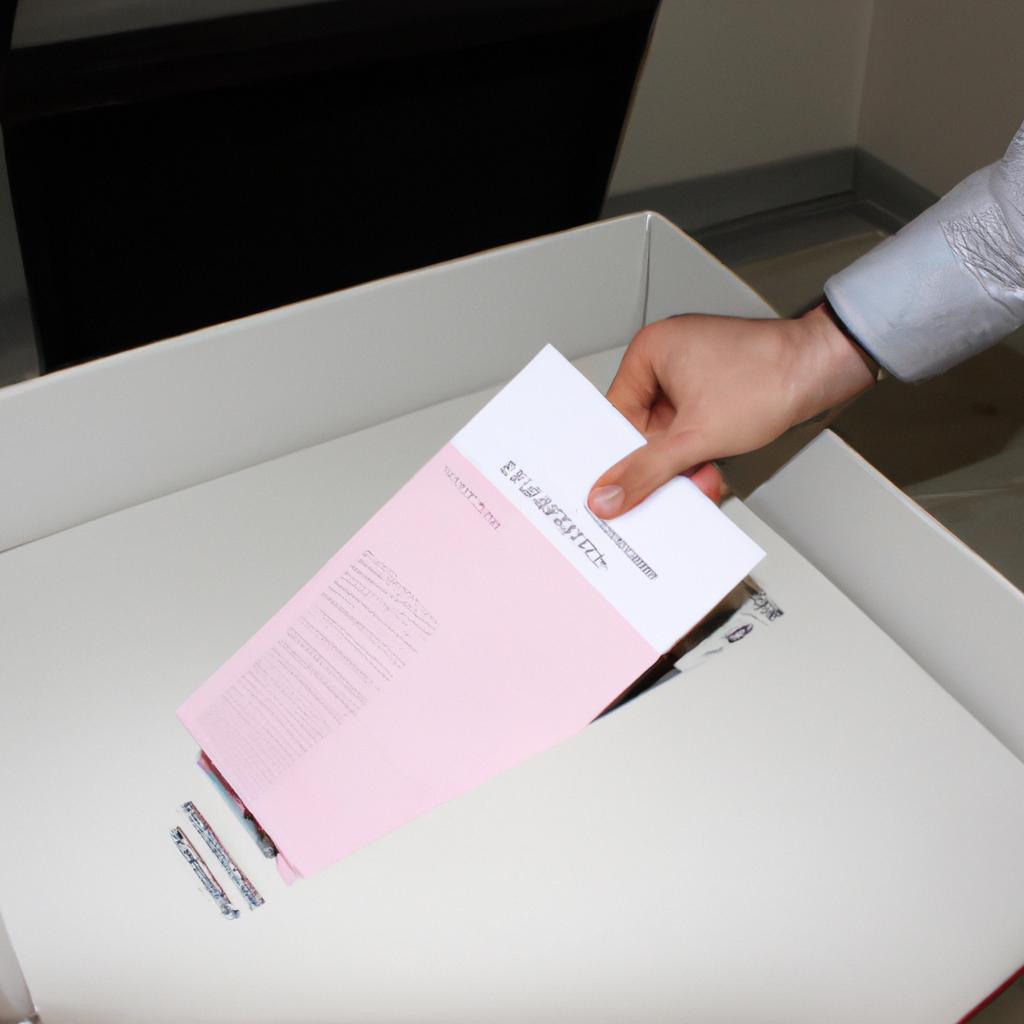Ranked-choice voting (RCV) has gained significant attention in recent years as a potential solution to the challenges posed by traditional plurality systems. In Pennsylvania, a state known for its complex and often contentious electoral landscape, the Reform Party has emerged as one of the leading proponents of implementing RCV. This article will explore the concept of ranked-choice voting and delve into how it could potentially transform Pennsylvania’s political landscape.
To illustrate the impact of ranked-choice voting, let us consider a hypothetical case study involving a closely contested mayoral race in a major city within Pennsylvania. Under the current plurality system, Candidate A secured 42% of the vote while Candidates B and C received 38% and 20%, respectively. Despite having only a slim majority, Candidate A emerged victorious due to receiving more votes than any other candidate individually. However, under an RCV system, voters would have had the opportunity to rank their preferences instead of casting just one vote. In this scenario, supporters of Candidates B and C who preferred either candidate over Candidate A could have ranked them accordingly. As a result, if neither Candidate B nor C achieved an outright majority in the first round of counting, subsequent rounds would be conducted until one candidate reached a majority threshold through redistributed preferences from eliminated candidates . This process of redistributing preferences allows for a more inclusive and representative outcome, as it takes into account the preferences of voters beyond their initial choice.
In our hypothetical case study, let’s assume that in the first round of counting, Candidate A receives 42% of the vote, Candidate B receives 38%, and Candidate C receives 20%. Since no candidate has reached the required majority threshold (50% +1), the candidate with the fewest votes (Candidate C) would be eliminated. The second-choice preferences of voters who initially supported Candidate C would then be redistributed to Candidates A and B.
Let’s say that 70% of Candidate C’s supporters ranked Candidate B as their second choice, while the remaining 30% ranked Candidate A as their second choice. These redistributed preferences would then be added to the existing totals for Candidates A and B.
After redistributing preferences, let’s assume that Candidate A now has 48% of the total votes (including redistributed preferences) and Candidate B has 52%. With this new distribution, Candidate B surpasses the majority threshold and is declared the winner.
This example demonstrates how ranked-choice voting can lead to a different outcome compared to traditional plurality systems. It allows voters to express their true preferences without fear of wasting their vote or splitting support among similar candidates. Additionally, RCV encourages candidates to appeal to a broader range of voters since they must actively seek second-choice rankings from supporters of other candidates.
Implementing ranked-choice voting in Pennsylvania could have significant implications for future elections. It may encourage more diverse candidates to run for office, foster greater collaboration among political parties, reduce negative campaigning tactics, and ultimately result in outcomes that better reflect the overall will of voters.
It should be noted that implementing RCV requires changes to election laws and procedures. This includes educating voters on how RCV works and ensuring accurate tabulation methods are in place. However, many jurisdictions across the United States, including cities like San Francisco and Minneapolis, have successfully implemented RCV and seen positive results.
As the Reform Party continues to advocate for ranked-choice voting in Pennsylvania, it will be essential to engage with policymakers, community leaders, and the public to build support for this electoral reform. By embracing RCV, Pennsylvania has the potential to revolutionize its political landscape and create a more inclusive and representative democracy.
What is Ranked-Choice Voting?
Ranked-Choice Voting (RCV) is a voting system that allows voters to rank candidates in order of preference. Instead of casting a single vote for one candidate, RCV enables voters to express their preferences by ranking multiple candidates on the ballot. This method offers several advantages over traditional plurality voting systems and has gained attention as a potential reform measure in various states.
To better understand how RCV works, consider an example: Suppose there are three candidates running for mayor in a city – Candidate A, Candidate B, and Candidate C. Under traditional plurality voting, each voter would choose only one candidate, and the candidate with the most votes would win. However, with RCV, voters have the option to rank all three candidates according to their personal preferences.
This ability to rank candidates gives rise to some distinctive features of Ranked-Choice Voting:
- Elimination process: If no candidate receives a majority of first-choice votes (50% + 1), the candidate with the fewest first-choice votes is eliminated from contention.
- Transfer of votes: Once a candidate is eliminated, those who ranked them as their top choice will then have their second-choice votes counted instead.
- Multiple rounds: The elimination process continues until one candidate reaches the required majority threshold or until only two candidates remain.
- Reduced strategic voting: With RCV, voters can feel more comfortable expressing support for lesser-known or third-party candidates without fear of wasting their vote.
By incorporating these unique elements into the electoral process, Ranked-Choice Voting aims to provide greater representation and ensure that elected officials truly reflect the collective will of the electorate. In Pennsylvania Reform Party’s quest for electoral reform, implementing this system could potentially lead to fairer and more representative outcomes in elections.
Moving forward, it becomes essential to explore how Ranked-Choice Voting actually operates within an election setting. How does this alternative approach translate into real-world scenarios? Let us delve deeper into the mechanics of Ranked-Choice Voting to better understand its workings and potential impact.
How does Ranked-Choice Voting work?
Ranked-Choice Voting: Pennsylvania Reform Party’s Voting System
In the previous section, we explored the concept of ranked-choice voting and its potential benefits. Now, let us delve deeper into how this innovative voting system works.
To better understand the mechanics of ranked-choice voting, consider a hypothetical scenario where five candidates—Alex, Ben, Chris, Dana, and Erin—are running for office in an election using this system:
- Voters rank their preferred candidates in order of preference on the ballot.
- During the counting process, if any candidate receives an outright majority (i.e., more than 50% of first-preference votes), they are declared the winner.
- If no candidate obtains a majority in the first round, the candidate with the fewest first-preference votes is eliminated from contention.
- Votes cast for the eliminated candidate are then redistributed to the remaining candidates based on voters’ second preferences.
- The process continues until one candidate secures a majority and emerges as the winner.
This method ensures that every vote counts by allowing individuals to express their preferences beyond just selecting their top choice. By eliminating weak or unpopular candidates progressively throughout multiple rounds of counting, ranked-choice voting encourages consensus building among voters and fosters fair representation.
Furthermore, implementing ranked-choice voting can have several positive implications:
- Promotes inclusivity and diversity in political representation
- Encourages higher voter turnout rates
- Reduces negative campaigning and promotes civility among candidates
- Enhances overall democratic legitimacy
By adopting ranked-choice voting systems like those employed by the Pennsylvania Reform Party, states can strive towards a more equitable electoral process that reflects diverse perspectives and allows citizens to make nuanced choices when casting their ballots.
Understanding how ranked-choice voting operates lays a strong foundation for comprehending its advantages and the potential impact it can have on democratic processes.
Advantages of Ranked-Choice Voting
How does Ranked-Choice Voting work?
Ranked-Choice Voting (RCV), also known as instant-runoff voting, is a voting system that allows voters to rank candidates in order of preference. Instead of simply selecting one candidate, voters have the option to indicate their first choice, second choice, and so on. This method ensures that if no candidate receives an outright majority in the initial count, subsequent rounds are conducted where lower-ranked candidates are eliminated and their votes redistributed based on voter preferences until a candidate achieves a majority.
To better understand how RCV works, let us consider a hypothetical scenario involving three candidates: Aisha, Ben, and Carlos. In the first round of counting, each ballot is tallied according to its top-ranked choice. If none of the candidates secure more than 50% of the vote, the lowest-ranking candidate is removed from contention. The ballots cast for this eliminated candidate now contribute towards determining the next highest-ranked choices on those particular ballots. This process continues until one candidate emerges with a majority.
To illustrate further the benefits of implementing ranked-choice voting systems like RCV, here are some key advantages:
- Promotes majority winners: By ensuring that winning candidates receive a true majority support from voters (over 50%), RCV helps eliminate situations where individuals win elections without gaining broad public consensus.
- Encourages positive campaigning: Candidates have an incentive to seek out second or third-place rankings since these can significantly influence election outcomes. Consequently, campaigns tend to focus less on negative attacks and more on appealing broadly to different voter groups.
- Reduces strategic voting: With RCV, voters don’t need to worry about “wasting” their vote by supporting lesser-known or third-party candidates they genuinely prefer. They can express their honest preferences through ranking without fearing it might inadvertently help elect their least preferred option.
- Enhances representation: RCV can lead to more diverse and representative elected bodies by giving underrepresented groups a better chance of winning. Candidates who may have broad appeal but are traditionally overlooked or face barriers in the single-choice voting system can gain greater support through second- or third-place rankings.
In light of these advantages, it becomes evident that ranked-choice voting has gained traction as an alternative to traditional plurality-based systems. It introduces fairness, encourages positive campaigning, mitigates strategic voting concerns, and helps foster inclusive representation within democratic processes. However, despite its merits, there exist certain criticisms and challenges associated with implementing RCV effectively.
Next section: Disadvantages of Ranked-Choice Voting
Disadvantages of Ranked-Choice Voting
In recent years, various states and political parties have considered implementing ranked-choice voting (RCV) as a potential solution to some of the shortcomings of traditional plurality voting systems. One notable example is the Pennsylvania Reform Party’s proposed adoption of RCV. By examining the advantages associated with this alternative voting system, we can better understand its potential impact on elections.
One advantage of ranked-choice voting is that it encourages candidates to engage in more positive campaigning rather than resorting to negative tactics. With RCV, candidates need to appeal not only to their core supporters but also to those who may rank them lower initially. This incentivizes candidates to focus on issues that resonate with a broader range of voters, fostering a more constructive and issue-based campaign environment.
Furthermore, RCV allows voters to express their true preferences without fear of strategic voting. In traditional plurality systems, voters often feel compelled to support a perceived frontrunner or compromise candidate instead of casting their vote for someone they genuinely prefer. However, in an RCV system, voters can rank candidates based on their actual preferences without worrying about wasting their vote or inadvertently aiding a less-preferred candidate.
The transparency and inclusivity provided by ranked-choice voting are additional benefits worth considering. Under this system, all viable candidates have an equal opportunity to present themselves to voters, even if they belong to smaller parties or face significant financial constraints. Moreover, RCV ensures that winners represent majority support since it requires the winning candidate to secure over 50% of votes after subsequent rounds.
Emotional Response:
- Increased political civility
- Genuine expression of voter preferences
- Fair representation for minority parties/candidates
- Strengthened democratic legitimacy
| Advantages of Ranked-Choice Voting |
|---|
| Encourages positive campaigning |
| Allows genuine expression of voter preferences |
| Provides opportunities for minority parties/candidates |
| Ensures fair representation and democratic legitimacy |
In summary, ranked-choice voting offers several advantages over traditional plurality systems. It promotes positive campaigning, allows voters to express their true preferences without strategic considerations, and ensures a fairer representation of the electorate’s will. These benefits contribute to a more inclusive and democratic electoral process. In the following section, we will explore the potential implementation of ranked-choice voting in Pennsylvania and its implications for future elections.
Implementation of Ranked-Choice Voting in Pennsylvania
Ranked-Choice Voting: Pennsylvania Reform Party’s Voting System
Disadvantages of Ranked-Choice Voting
While ranked-choice voting (RCV) has gained popularity in several states, it is not without its drawbacks. One notable disadvantage is the potential for voter confusion and complexity. The concept of ranking candidates can be challenging for some voters to grasp, leading to errors or incomplete rankings on their ballots. This may result in a less accurate reflection of voters’ preferences and potentially skew the outcome.
Another concern with RCV is that it can prolong the election process due to the need for multiple rounds of tabulation. While this allows for more comprehensive representation by considering second and subsequent choices, it also extends the time needed to determine a winner. In situations where a quick resolution is necessary, such as during times of crisis or urgent decision-making, RCV might not be practical.
Additionally, opponents argue that RCV can lead to strategic voting tactics. Voters may feel compelled to rank candidates strategically rather than based solely on their genuine preference. This could undermine the principle of honest expression of individual choice and potentially distort election outcomes.
Implementation of Ranked-Choice Voting in Pennsylvania
To address these concerns and ensure an effective implementation of RCV within the Pennsylvania Reform Party’s voting system, certain considerations should be taken into account:
- Voter education campaigns: A robust educational initiative should be undertaken to familiarize voters with how RCV works and alleviate any confusion surrounding ballot-ranking procedures.
- Improved technology infrastructure: Investing in reliable and user-friendly voting systems will help minimize errors during the tabulation process while ensuring accurate results are obtained efficiently.
- Clear guidelines for candidate eligibility: Establishing clear criteria for candidacy will prevent frivolous entries from individuals seeking to exploit the complexities inherent in RCV.
- Ongoing evaluation and refinement: Regular assessment of RCV’s impact on elections should be conducted, allowing adjustments to be made if necessary to address any unintended consequences.
The successful implementation of ranked-choice voting in Pennsylvania would require a concerted effort to mitigate potential disadvantages and create an environment that maximizes the benefits of this electoral system. By addressing concerns through voter education, technological improvements, clear guidelines, and ongoing evaluation, RCV can be effectively integrated into the Pennsylvania Reform Party’s voting system.
Impact of Ranked-Choice Voting on the Pennsylvania Reform Party
To fully comprehend the implications of implementing ranked-choice voting within the Pennsylvania Reform Party’s framework, it is crucial to examine its potential impact on party dynamics and candidate selection processes. This analysis will shed light on how RCV may shape decision-making strategies and ultimately influence the outcomes of elections within the party.
Impact of Ranked-Choice Voting on the Pennsylvania Reform Party
Ranked-Choice Voting: Pennsylvania Reform Party’s Voting System
Following the decision to adopt ranked-choice voting (RCV) in Pennsylvania, the implementation process has been carefully orchestrated by the Pennsylvania Reform Party. This section will explore how RCV is being introduced and integrated into the state’s electoral system.
To illustrate this implementation process, let us consider a hypothetical scenario where RCV is implemented for local elections in Philadelphia. Under this new system, voters would have the opportunity to rank candidates in order of preference, rather than selecting just one candidate as they did previously. To ensure clarity and ease of use, educational campaigns led by the Pennsylvania Reform Party would be conducted prior to the first election utilizing RCV. These campaigns would aim to inform citizens about the mechanics of ranking candidates and emphasize its benefits in creating fairer and more representative outcomes.
The transition towards implementing RCV involves several key steps:
-
Legislative Changes:
- The Pennsylvania Reform Party advocates for legislative reforms that facilitate the adoption of RCV.
- Collaboration with lawmakers helps draft bills or propose constitutional amendments necessary for enacting RCV.
- Public hearings are held to gather input from stakeholders, ensuring transparency and inclusivity throughout the process.
-
Voter Education:
- The Pennsylvania Reform Party launches an extensive voter education campaign early on.
- Educational materials, such as brochures and online resources, are developed to explain how RCV works.
- Workshops and public forums are organized to address any concerns or questions raised by voters regarding this new voting method.
-
Ballot Design:
- Collaborating with experts in ballot design ensures that ballots are user-friendly and intuitive for voters.
- Clear instructions guide voters through each step of ranking their preferred candidates.
-
Technological Infrastructure:
- The implementation plan includes modernizing technological infrastructure within polling stations to accommodate RCV.
- Upgrades to voting machines and software are undertaken, ensuring accurate vote tabulation while maintaining the secrecy of individual ballots.
As the implementation process unfolds, it is crucial for the Pennsylvania Reform Party to maintain open lines of communication with voters. By addressing concerns, providing comprehensive education, and engaging citizens in this transformational endeavor, RCV has the potential to enhance democracy in Pennsylvania by fostering greater voter participation and promoting more representative outcomes.




